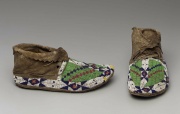Glass bead
Description
Modern spherical glass beads are produced by spraying molten glass into a partially evacuated chamber. Various sizes of solid and hollow spheres (Microballoon) are made ranging from a fine powder to 1/4 inch in diameter. Glass beads are used as fillers in polymers to increase strength and provide sound and thermal insulators.
Decorative glass beads have been made since ancient times in Egypt, Rome and Greece. First created about 3500 years ago in Egypt, glass beads replaced, beads made from faience, glazed steatite, bones, stones, pearls and shells. The beads were often constructed by winding a thin thread of drawn-out glass around a wire. This produces a spiral effect and left a tiny tail where the glass thread was separated from the bead. An alternative method was to take one or more glass rods, or canes, and cut them to the bead size, They were then folded around a wire then fused to make a tube. Sometimes the tubes were stretched to make longer cylindrical beads. For detailed information on decorative bead production, see History of Venetian Glass Beads.
Synonyms and Related Terms
glass sphere; perle de verre (Fr.); glazen kraal (Ned.); conta de vidro (Port.)
Applications
- Decorations, jewelry
- Spacers, fillers, etc.
- Weight bags
Resources and Citations
- Conservation termlist: www.hants.org.uk/museums (Historical technology)
- Wikipedia: https://en.wikipedia.org/wiki/Glass_beadmaking (access 8/20)
- History of Venetian beads link (Accessed 8/20)

